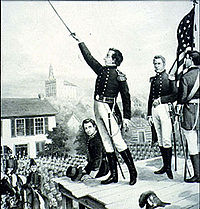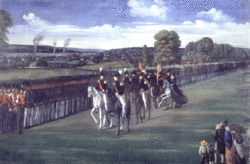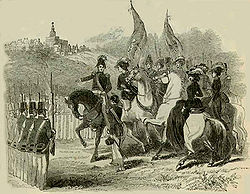- Nauvoo Legion
-
 Gen. Joseph Smith, Jr. addressing the Nauvoo Legion.
Gen. Joseph Smith, Jr. addressing the Nauvoo Legion.
The Nauvoo Legion was a militia originally organized by the Latter Day Saints (Mormons) to defend the city of Nauvoo, Illinois, (Hebrew: נָאווּ, Modern Navu Tiberian Nâwû ; “to be beautiful”). To curry political favor with the ambiguously-political Saints, the Illinois state legislature granted Nauvoo a liberal city charter that gave the Nauvoo Legion extraordinary independence. Led by Joseph Smith, Jr., founder of the Latter Day Saint movement and mayor of Nauvoo, the Legion quickly became a formidable concentration of military power in the American West. In 1844, after a controversy stemming from the Nauvoo city council's suppression of a Nauvoo newspaper critical of Smith and his church's policies, Smith mobilized the Legion and declared martial law. Arrested for treason, Smith was assassinated by a mob before the Legion could come to his aid. Soon thereafter, the Nauvoo charter was revoked, and the Nauvoo Legion lost its official sanction as an arm of the Illinois militia.
After Smith's death, the unsanctioned Nauvoo Legion continued to operate under the command of Brigham Young, leader of the movement's largest faction, The Church of Jesus Christ of Latter-day Saints (LDS Church). Young led his people to what later became the Territory of Utah. It retained its name even after the exodus out of Nauvoo. The Legion effectively became part of the church's military arm. It was mobilized in opposition to the United States Army during the largely peaceful Utah War, and the Legion's southern Utah battalion was responsible for the Mountain Meadows massacre. It was permanently disbanded in 1887 as part of the Edmunds-Tucker Act, which disincorporated the LDS Church because of its practice of polygamy.
Contents
Formation
In 1839, Joseph Smith relocated his followers—the Mormons—from a hostile environment in Missouri to Commerce, Illinois which he renamed Nauvoo. Voter-conscious Illinois Democrats and Whigs (including Abraham Lincoln) passed a bipartisan city-state charter for Nauvoo in 1840. On December 16 the governor signed it into law, granting Smith and the city of Nauvoo broad powers. Among these was the authority to create a "body of independent militarymen". This force was a militia similar to others in Illinois, and it became known as the "Nauvoo Legion". At its peak, the militia had, by conservative estimates, at least 2,500 troops, in comparison to the approximately 8,500 troops within the entire United States Army as of 1845.[1] The Legion was organized into two regiments (called cohorts) of infantry and one regiment of cavalry. A few light cannon were also attached.
The Legion tended to be very top-heavy, in that there was a disproportionate number of high-ranking officers to regular soldiers. Supposedly, this was to elevate the social status and official standing of some members of the city.
The Legion was able to draw on Federal stands of arms. The most common musket issued to these militiamen was the Model 1816 Musket. This flintlock musket was an American built copy of the French 1777 Charleville musket. Also, the Harper's Ferry Model 1803 Rifle was issued in smaller quantities. Personal arms were also used. A small artillery piece, a mountain gun, was also issued. It was nicknamed the "Old Sow" and is on display at the Church Museum of History in Salt Lake City.
Although the charter authorizing the Nauvoo Legion created an independent militia, it could be used at the disposal of the state governor or the President of the United States as well as for the mayor of Nauvoo. Joseph Smith himself was Nauvoo's second mayor, and the Nauvoo court martial also appointed him as highest ranking officer of the Legion, a Lieutenant General. This rank is one step above Major General which most contemporary militias employed as their commanding rank. One motive for the higher rank was to prevent Smith from being tried in a court martial by officers of lesser rank. In 1837 the Missouri militia had contemplated a court martial against Smith, an action that might have been illegal had it been carried out, as Smith was only a civilian at that time.
In the last month of his life, June 1844, Smith declared martial law in Nauvoo in response to various civil disturbances and initially deployed the Legion to defend the city, only to restrain the Legion from any action later. He urged Legion members to not take any action when the Illinois governor ordered Smith's arrest. The Mormon leader surrendered at Carthage jail, and was supposed to be under the protection of Governor Ford and the Carthage Greys, the militia of the neighboring city. However, on June 27, 1844, members of the Carthage Greys joined a mob that stormed the jail and killed Joseph Smith and his brother Hyrum.
After the death of Joseph Smith
The Legion survived the loss of its commanding officer, and Brigham Young became the new commander of the militia in August, 1844, though he had never previously been active in Legion activities. Rather than employ the Legion to protect his people from increased mob violence, Young directed most of his followers to leave the city, and Illinois was abandoned by the Mormons entirely by September 17, 1846 after a week of artillery shelling called the "Battle of Nauvoo".
Upon revocation of the Nauvoo Charter in the winter of 1844-1845, the Legion was no longer recognized as a state militia, and its members returned the majority of its government-issued arms. Depleted of its official status, the Legion assumed a very minor role in future Church affairs after being reorganized in Iowa by Hosea Stout on September 22, 1846. It was never actively employed in defense of the Mormon people until the Utah War in which it served mainly to erect defenses and harass the federal army led by Gen Johnston.
In Utah
Some legionnaires served in the 500-man Mormon Battalion for the U.S. government in 1846 as part of its campaign against Mexico. However, the Nauvoo Legion itself resurfaced to prominence soon after Brigham Young led the first band of Mormons to Utah, then called Deseret, in 1847. Under territorial law, the Nauvoo Legion became the territorial militia in 1852 although it retained its name.
1849 conflicts with Native Americans in Utah County, such as the attack at Battle Creek, Utah, foreshadowed the 1853-1854 Walker War between the Nauvoo Legion and Indians led by Chief Walkara ("Walker"). Twenty servicemen and many more Native Americans died in the Walker War.
The Legion was used again in the so-called "Utah War" against Federal troops entering Utah in the "Utah Expedition" from 1857-1858.
At the beginning of this conflict and period of heightened tension in September 1857 Colonel William Dame ordered a brigade be formed out of the existing four battalions of the Nauvoo Legion's 10th Regiment or the Iron Military District, which ultimately helped carry out the Mountain Meadows massacre of 120 Arkansas immigrants traveling through Southern Utah. Children under 8 years of age were spared.
After this conflict, the Federal government appointed Utah's territorial governor, and the Nauvoo Legion was allowed to exist supposedly at the command of the governor. However, it was widely known the Legion was more responsive to Latter-day Saint leaders than appointed government officials.
During the American Civil War, two units of the reorganized Nauvoo Legion were gainfully employed by the United States to protect western mail and telegraph lines from attack.
The final use of the Legion was in Utah's Black Hawk War 1865-1868 when over 2,500 troops were dispatched against Indians led by Antonga Black Hawk. (Antonga Black Hawk was a Ute and has no connection to the Illinois Sauk chief Black Hawk of the 1830s.) In 1870 the Utah Territorial governor, J. Wilson Shaffer forced the Legion inactive unless he ordered otherwise. Federal troops dispatched in response to the 1870 Ghost Dance ensured Shaffer's order was enforced. The Nauvoo Legion never gathered again, and the 1887 Edmunds-Tucker Act permanently disbanded it. In 1894, in anticipation of statehood, the Utah National Guard was organized as Utah's official state militia.
See also
Notes
- ^ Allaman (1990, p. 11).
References
- Allaman, John Lee (1990), "Uniforms and Equipment of the Black Hawk War and the Mormon War", Western Illinois Regional Studies XIII (1): 5, http://www.archive.org/details/westernillinoisr_spring90west.
- Allen, James B.; Leonard, Glen M. (1976), The Story of the Latter-day Saints, Salt Lake City, UT: Deseret Book Co., ISBN 0-87747-594-6.
- Flanders, Robert Bruce (1975), Nauvoo: kingdom on the Mississippi (3rd ed.), University of Illinois Press, ISBN 9780252005619.
- Gardner, Hamilton (1961), "Nauvoo Legion, 1840-1845 -- a unique military organization", Journal of the Illinois State Historical Society 54 (Summer): 181–197, http://dig.lib.niu.edu/ISHS/ishs-1961summer/ishs-1961summer-181.pdf
- Roberts, Richard C. (2003), Legacy: the history of the Utah National Guard from the Nauvoo Legion era to Enduring Freedom, Utah (?): National Guard Association of Utah, pp. 5, 9, ISBN 0-9-72849-0-6, OCLC 53168159
- Roberts, Richard C. (2004), "Utah National Guard and Territorial Militias", in Powell, Allan Kent, Utah History Encyclopedia, Salt Lake City: University of Utah Press, http://www.media.utah.edu/UHE/u/UTAHNATIONALGUARD.html, retrieved 2007-07-08
- "Territorial Militia Records, 1849-1877". Series 2210. Utah State Archives and Records Service. 1960-1990. OCLC 80116284. http://historyresearch.utah.gov/inventories/2210.html. Retrieved 2007-07-08.
External links
- Utah History Encyclopedia: The Utah National Guard and Territorial Militias
- LDS.org, Images of Old Nauvoo: Mormon Legion
The Latter Day Saint movement Fundamental ideas Mormonism · Latter Day Saint · Mormonism and Christianity · Mormon Fundamentalism · Latter Day Saint denominations · List of sects · Mormon studies
History Sacred texts Founders & leaders Doctrines & practices Views on Godhead · Views on Jesus · Priesthood · Articles of Faith · Restoration · Mormonism and Judaism · Temples
Controversies Criticism · Joseph Smith, Jr. and polygamy · Blacks and the Latter Day Saint movement · Oath of vengeance · Mountain Meadows massacre · Historicity of the Book of Mormon
See also Latter Day Saints Portal – Category MormonismCategories:- Pre-state history of Utah
- History of The Church of Jesus Christ of Latter-day Saints
- History of the Latter Day Saint movement
- Utah in the American Civil War
- Utah War
- Organizations established in 1840
- 1870 disestablishments
- The Church of Jesus Christ of Latter-day Saints in Utah
- Latter Day Saint movement in Illinois
- Nauvoo Legion
- United States private paramilitary groups
- Church of Christ (Latter Day Saints)
Wikimedia Foundation. 2010.


